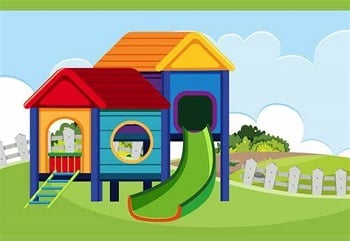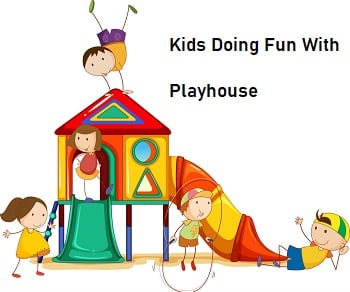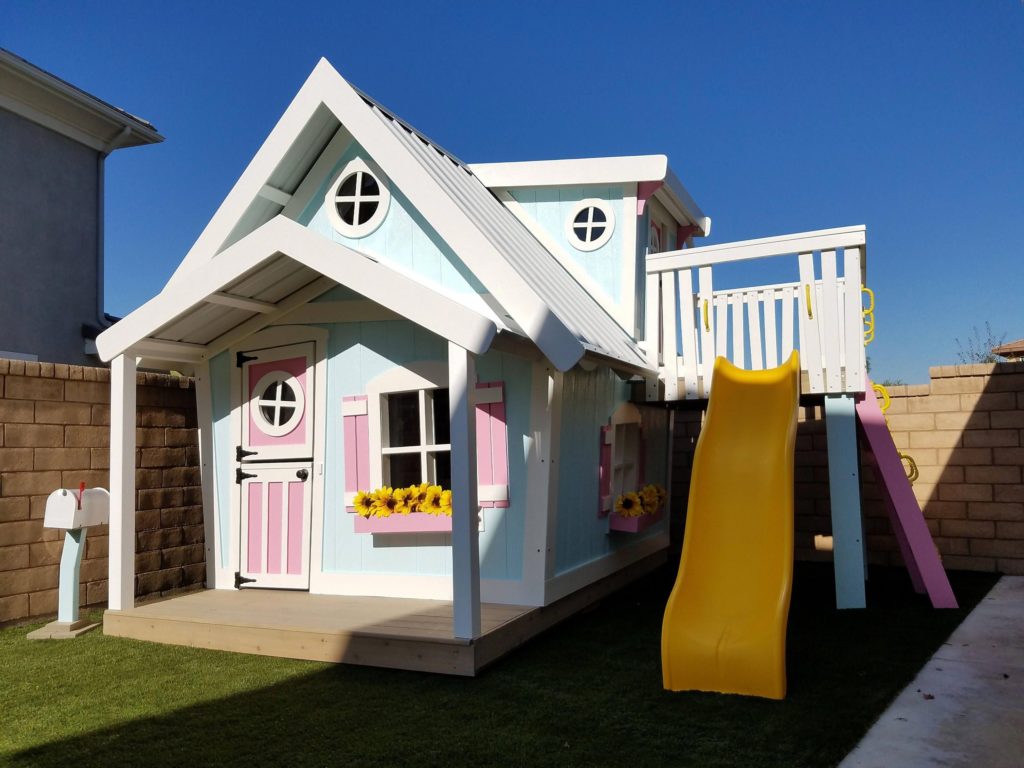When I was twenty-two years old, I wanted two things: 1. To be understood. 2. For people to think I was good at my job....Read more
Regarding what to put on the ground under a playhouse, there are a few options depending on your preferences and needs. If the playhouse is set up on a grassy area or natural ground, consider leaving it as is. However, remember that heavy play or frequent foot traffic might wear down the grass over time.
Many people choose to use rubber mulch or wood chips as a safety surface under the playhouse. These materials provide a soft and cushioned landing in case of falls, helping to reduce the risk of injuries. Sand is another popular choice for playhouse ground covering. It’s great for building sandcastles and promotes imaginative play. However, remember that sand might require regular upkeep and can get messy.

Rubber or foam mats are an excellent way to create a soft and supportive surface under the playhouse. These mats are easy to install and maintain, making them a practical choice. Consider a poured rubber surface for a more permanent and professional option. This surface type offers excellent shock absorption and is long-lasting but can be a bit more expensive.
The choice ultimately depends on your budget, how you want the play area to look, and the level of safety you want to provide. Whichever option you choose, ensure that the ground under the playhouse is safe and well-maintained, so the little ones can have fun without worrying about getting hurt.
What is the purpose of a playhouse?
The purpose of a playhouse is to provide a designated and imaginative space for children to engage in creative and recreational activities. Playhouses are designed to encourage imaginative play and social interaction, essential aspects of a child’s development. Children can explore various roles, scenarios, and emotions through play, helping them understand the world and develop important cognitive, emotional, and social skills.

Playhouses come in various forms, including outdoor structures in gardens or backyards and indoor play areas. These spaces often include elements such as slides, swings, climbing structures, and pretend play areas, all of which stimulate a child’s imagination and foster physical activity.
Benefits of playhouses
Imagination and Creativity
Playhouses allow children to create their worlds and scenarios, stimulating their creativity and imaginative thinking.
Social Skills
Playing in a group setting in a playhouse promotes social interaction, cooperation, and communication among children.
Physical Development
Activities in playhouses, such as climbing, sliding, and running, contribute to developing gross motor skills and coordination.
Emotional Development
Playhouses provide a safe environment for children to express their emotions and feelings while engaging in role-playing and make-believe situations.
Cognitive Skills
Through play, children can develop problem-solving abilities, critical thinking, and decision-making skills.
Emotional Regulation
Playhouses offer a space for children to engage in free play, which can help reduce stress and anxiety, allowing them to manage their emotions effectively.
Learning Opportunities
Playhouses can be educational, featuring elements like alphabet panels, counting games, or kitchens that enhance early learning experiences.
Playhouses play a crucial role in a child’s growth and development, promoting fun, learning, and social interaction in a safe and supportive environment.
What to put under a plastic playhouse?
When it comes to what to put under a plastic playhouse, there are a few options you can consider. The goal is to create a safe and comfortable surface for the kids to play on. Here are some ideas:
1. Rubber or Foam Mats. Using rubber or foam mats is a fantastic option. These mats provide a soft and cushioned surface that can help prevent injuries in falls or tumbles. They are easy to install, clean, and maintain.
2. Interlocking Play Tiles. Interlocking play tiles are designed specifically for play areas. They come in various materials like rubber or foam and offer excellent shock absorption and durability.
3. Rubber Mulch or Wood Chips. Consider using rubber mulch or wood chips if you prefer a more natural look. These materials provide a soft landing and are often used in playgrounds for their safety benefits.
4. Artificial Grass. Artificial grass can be a great choice for a low-maintenance and clean surface. It’s soft, looks like real grass, and provides a nice play area for kids.
5. Sand. Sand can be an option if the playhouse has a sandpit or you want to encourage sand play. However, remember that sand may require more maintenance, as it can get messy and need occasional refilling.
6. Poured Rubber Surface. Consider a poured rubber surface for a more permanent and professional solution. This option offers excellent shock absorption and is long-lasting.
Before deciding, consider your budget, the aesthetics you want, and the safety aspects you prioritize. The most important thing is ensuring the surface is level, safe, and free from hazards. The little ones will have a blast in their plastic playhouse, and with the right ground covering, you’ll have peace of mind knowing they’re playing on a secure and enjoyable surface.
What do you put under play bark?
When using play bark in a play area, preparing the ground properly is essential to ensure safety and effectiveness. Play bark, also known as playground mulch or wood chips, is commonly used as a ground cover in play areas due to its cushioning properties, which help reduce the risk of injuries from falls. Here’s what you should put under play bark:
Landscaping Fabric or Weed Barrier
Before laying the play bark, placing a landscaping fabric or weed barrier over the ground is a good idea. This fabric prevents weeds and plants from growing up through the play bark, keeping the area cleaner and easier to maintain.
Leveling Material
Ensure the ground is level and free from large rocks, roots, or debris that could cause unevenness. Leveling the area helps create a safer and more even playing surface.
Shock-Absorbing Base
For added safety, you can consider installing a shock-absorbing base material, such as rubber mats or foam pads, under the play bark. This additional layer provides extra cushioning and impact absorption in case of falls.
Drainage
If your play area is outdoors and prone to rain or wet conditions, ensure proper drainage to avoid water pooling. This can be achieved by creating a slight slope or using drainage systems.
Sufficient Depth of Play Bark
The thickness of the play bark layer is crucial for its effectiveness in reducing injuries. The depth should generally be around 6 to 12 inches, depending on the height of the play equipment. Be sure to maintain the appropriate depth over time, as the bark may settle or decompose.
By following these steps and putting the right materials under the play bark, you can create a safe and enjoyable play area for children to have fun, explore, and play with reduced risk of injuries. Always ensure regular maintenance and inspections to keep the play area in excellent condition.
What to put under a wooden playhouse?
When setting up a wooden playhouse, it’s essential to prepare the ground properly to create a safe and comfortable play area for children. Here are some suggestions for what to put under a wooden playhouse:
- Level Surface. Ensure the ground under the wooden playhouse is level. Remove any rocks, roots, or debris and make sure the surface is smooth and even to prevent tripping hazards.
- Pressure-Treated Lumber or Concrete Pavers. To elevate the playhouse slightly off the ground and protect it from moisture, consider placing pressure-treated lumber or concrete pavers as a foundation. This helps to prevent rot and prolong the life of the wooden structure.
- Landscaping Fabric or Weed Barrier. Before adding any ground covering, lay down a landscaping fabric or weed barrier. This prevents weed growth, helps keep the area cleaner, and makes maintenance easier.
- Rubber or Foam Mats. You can place rubber or foam mats under the playhouse for additional safety and cushioning. These mats provide a softer landing surface in case of falls and create a more comfortable play area.
- Wood Chips or Mulch. Wood chips or mulch are popular for playhouse ground covering. They provide a natural and soft surface that can help reduce the impact of falls and create a visually appealing play area.
- Artificial Grass. Artificial grass is another option that provides a soft and low-maintenance play surface. It offers the look of real grass without watering or mowing.
- Poured Rubber Surface. Consider a poured rubber surface for a more permanent and professional solution. This option offers excellent shock absorption and durability but may require professional installation.
Before deciding, consider your budget, the desired aesthetics, and the safety aspects you prioritize. Regardless of the ground covering, proper preparation and regular maintenance will ensure that the wooden playhouse provides a fun and safe environment for children to enjoy their playtime.
Can you use a shed as a playhouse?
You can use a shed as a playhouse! Many people repurpose sheds and turn them into awesome play spaces for kids. It can be a fun and creative way to provide a designated area for play while making the most out of existing structures.
Here are some things to consider if you’re thinking about using a shed as a playhouse:
Safety First
Before transforming the shed, make sure it’s safe for children to play in. Check for hazards like sharp edges, exposed nails, or potential structural issues. Fixing these concerns should be the top priority.
Insulation and Ventilation
Depending on the location and climate, consider adding insulation and proper ventilation to ensure a comfortable play environment, especially during extreme weather conditions.
Interior Design
Get creative with interior design! Add colorful paint, fun decorations, and child-friendly furniture to make the playhouse inviting and exciting for kids.
Childproofing
Childproof the shed by securing heavy items, eliminating tripping hazards, and ensuring that doors and windows are easy to open and close for little ones.
Storage Space
Utilize some of the shed’s space for storing toys, art supplies, or other play items, keeping everything organized and within reach.
Electrical Safety
If you plan to add any electrical components, like lighting or fans, ensure they are installed safely and out of reach of children.
Outdoor Play Area
Consider creating an outdoor play area around the shed with swings, slides, or a sandbox to enhance the play experience.
The beauty of using a shed as a playhouse is that you can customize it to fit your child’s interests and needs. It’s a fantastic way to provide a dedicated play space without building a separate structure from scratch. Just let your imagination run wild
How big should a kid’s playhouse be?
The size of a kids’ playhouse can vary depending on factors such as the available space, the children’s age, and the playhouse’s intended use. However, there are some general guidelines to consider when determining how big a kids’ playhouse should be:
Age and Number of Children – Consider the age of the children using the playhouse and how many will play together. Younger children or toddlers require a smaller playhouse, while older kids or if you expect multiple children to play together, a larger playhouse is more suitable.
Available Space – Take into account the available space in your backyard or play area. Measure the area where you plan to place the playhouse to ensure it fits comfortably and leaves enough room for other activities or equipment.
Play Activities – Think about the types of play activities you want the kids to engage in within the playhouse. If you plan to include additional features like slides, swings, or play kitchens, you’ll need more space to accommodate these elements.
Headroom and Accessibility – Ensure the playhouse has enough headroom for the children to stand comfortably inside. Also, consider accessibility features, like door size and ramp or steps, so kids can easily enter and exit the playhouse.
Safety and Durability – If you’re building or purchasing a playhouse, ensure it meets safety standards and is constructed with durable materials that can withstand outdoor conditions.
As a rough estimate, a small playhouse might have dimensions around 4 feet by 4 feet or 5 feet by 5 feet, while a larger playhouse could range from 6 feet by 6 feet to 8 feet by 8 feet or even bigger.

Ultimately, the size of the playhouse should balance available space, the number of children using it, and the play activities you want to incorporate. It’s also essential to involve the kids in decision-making to ensure the playhouse meets their preferences and needs.

When I was twenty-two years old, I wanted two things: 1. To be understood. 2. For people to think I was good at my job. As a first time founder, I remember feeling under-qualified. I felt like an impostor—and it showed. I struggled to communicate my value in a way that my colleagues and potential investors could understand. I realized I needed to clarify my message and use social media as a tool to help me build my personal brand. This would help me look more credible, I thought. So I got to work. I updated my social media profiles, built a personal website, and began sharing my story online. The more content I shared, the more confident I became. And the more confident I became, the more credible I appeared. Now i am writing blogs for madeforkids.co.uk on different topics on kids.
- Latest Posts by Anna Vatuone
-
What Are The Uses Of A Drone
- -
What Are The Uses Of Playhouse
- -
How To Get A Child To Warm Up To You
- All Posts
